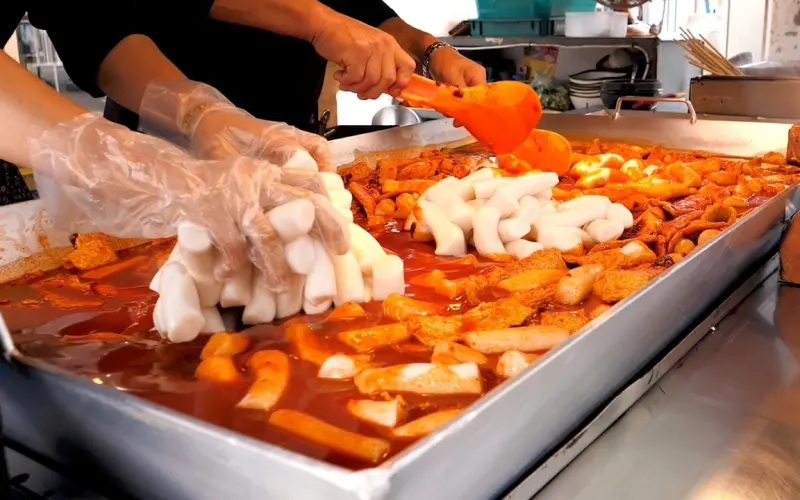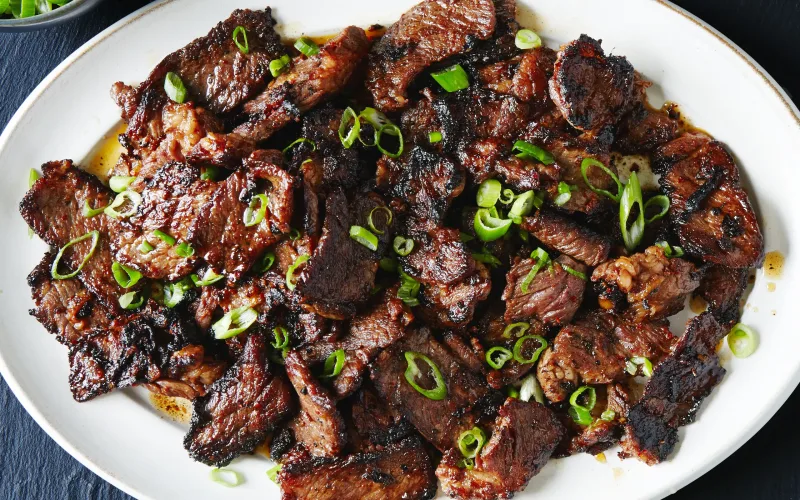
Traditional Korean Food
Korean food is one of my favourites in the world. Checkout this post to discover some absolute must try traditional Korean food!
Traditional Korean Food
If you live in Canada there is a good chance that you have tried or at least heard of Korean barbecue. If you haven’t, Korean barbecue is Korean-style meats served to your table raw along with accompaniments which you then cook on a hot plate at the table.
Oftentimes when I hear people tell me they enjoy Korean food and I ask which dishes they say that they have only gone to Korean barbecue so they don’t really know the names of the dishes. This is completely understandable because Korean barbecue is SO good but I wanted to make an introductory post to some traditional Korean dishes that I have had the pleasure of trying because these dishes are what made me fall in love with Korean food, with it now being one of my favourite cuisines in the world.
Also, I am officially an honorary reporter for Korea as appointed by the Korean Ministry of Tourism so I am going to try and share Korean content more frequently to promote the immense beauty of Korean food and culture!

What are key ingredients in traditional Korean food?
I think it is relevant to mention this for Korean cuisine because a couple of key ingredients are truly what take Korean dishes to another world of flavour in my opinion. Similar to other East Asian countries you will find the use of soy sauce, garlic and ginger in the preparation of meals, which for me is already enough to make my mouth water. Part of the magic of Korean cuisine though comes from two key ingredients, gochujang and doenjang.
These two ingredients are both fermented pastes, with gochujang being fermented chili paste and doenjang being fermented soybean paste. Unlike ssamjang which is a combination of these pastes and other ingredients and is often found as a thick dipping sauce at Korean barbecue restaurants, gochujang and doenjang are used during the cooking process. These two ingredients bring the most amazing spicy (in the case of gochujang) and savoury flavours to food imaginable.
I buy both from my local Asian grocery stores and go through them so fast because of how addictive the flavour it imparts is! Of course, Korean cuisine has a myriad of ingredients that make the food so incredible but I just wanted to bring awareness to these two because I think they are serious difference makers that I think everyone should have in their home!


What are some of my favourite Korean dishes?
I think there are a few Korean dishes that are an absolute must try for anybody who is less familiar with Korean food. It is also worth mentioning that these dishes are generally served with a side of rice as well as banchan which are various side dishes that are often fermented or pickled.
Kimchi
Starting off with banchan, or rather THE banchan, kimchi probably has my vote for the greatest side dish ever created. Kimchi is fermented vegetables, most commonly napa cabbage and Korean radish but there are a lot of varieties, combined with a bunch of spices of which the most outstanding to me are generally the gochugara (Korean chili powder) and jeotgal (salted seafood). What I love about kimchi is how much of a punch of flavour it provides.
The flavour is like having fermented, sour, spicy, seafoody, garlicy pickles! I also love how much variety there is between kimchis. Personally, I don’t like kimchi that has a strong seafood flavour for example so while most kimchis are usually great I can always get vegan kimchi as well which omits the seafood! So, if you have tried kimchi before and didn’t like it at first, I would highly recommend trying it again at a different establishment, with different vegetables, or a vegan version!

Tteokbokki
Moving on to an appetizer / street food, tteokbokki is absolutely amazing when done right. This dish consists of soft and chewy rice cakes drenched in a sauce/gravy that is spicy, sweet, and savoury. Remember how I mentioned gochujang earlier? Well in this dish gochujang shines and brings a flavour that you won’t forget! Restaurants typically serve this dish as an appetizer which I would highly recommend, otherwise you can find it at street food markets being sold in small bowls or with the rice cakes skewered onto sticks. If you have to choose one appetizer when you go to a Korean restaurant, I highly recommend tteokbokki!

Bibimbap
Now I must admit, out of all the dishes on this list I would perhaps have to put bibimbap at the bottom of my favourites. That’s not to say that I don’t love bibimbap its just a testament to how amazing these other dishes are and that I usually get this dish without the characteristic runny egg yolk because I am not a big fan of that. If you like runny egg yolks though you will love this dish!
It consists of rice, vegetables, meat, and the runny egg yolk as I mentioned often served within a heated clay bowl. You can then mix it altogether and add an additional sauce which is oftentimes served with bibimbap and is absolutely amazing. So, if you’re a fan of rice or just want a dish that is a bit less adventurous and with a bit less of a punch, I highly recommend bibimbap because it is an amazing rice dish with balanced flavours that everyone has to try!

Jiggae
Now for what is probably my FAVOURITE dish on this list, the classic Korean stew jjigae! This is a stew with meat/seafood and vegetables along with gochujang, doenjang, and pretty much every other seasoning that makes Korean food delicious. I believe the most common type of jjigae also happens to be kimchi jjigae so it is like combining two amazing dishes into one! You’re going to get a strong spicy, savoury and sour flavour with every bite that will leave you craving more. If you want a dish with strong flavours and lots of broth, I highly recommend jjigae.

Bulgogi
Something of a fan favourite from what I have seen, and I dish I absolutely love, bulgogi is a safe option for beef lovers. This dish consists of deeply marinated beef that is thinly sliced, super flavourful, and fall apart tender. It’s often grilled as well which further adds to the tremendous taste. When reading about this dish I discovered that the name means “fire” (bul) “meat” (gogi) in a North Korean dialect of Korean because this dish actually originates in North Korea which I thought was very interesting!

Dak Galbi
If you’re not a big beef fan and enjoy spicy food, dak-galbi is the perfect dish for you. It consists of stir-fried chicken with vegetables in a gochujang-based sauce. Interestingly, you may be familiar with the term “galbi” if you frequent Korean BBQ restaurants because this term means “ribs” and beef ribs are usually available at Korean BBQ. Now you may be wondering if they really use chicken ribs in dak-galbi and the answer is no, funnily enough this is just the name that was given to the dish even though it doesn’t use ribs!
This dish originates in Chuncheon during the 60s and arose to prosperity because there were a lot of chickens in Chuncheon and white meat was cheaper compared to dark meat, so this dish utilized white meat in a super delicious way and as such became popular among students and soldiers. I feel like some of the most amazing dishes come from humble origins like this and for dak-galbi the punch of flavour is something that you absolutely do not want to miss!

Jajangmyeon
Finally, a dish that highlights doenjang, jajangmyeon is a noodle dish in a fermented black bean-based sauce. This dish is super savoury and delicious with the sauce being so addictive you won’t be able to stop eating it. Interestingly, this dish was actually brought over by Chinese immigrants and originates from a Chinese dish called “zhajiangmian”. It has changed considerably over time though and has now become a classic Korean dish!
I actually tried jajangmyeon for the first time in Spain at the Yatai Market (which will get its own post in the future because this place was amazing) and it was super delicious. I will say it definitely wasn’t the best dish I tried and I think it has the potential to be a lot better than the one I tried so I am hoping I can find a spot that serves up amazing jajangmyeon in Canada… or maybe I just have to visit South Korea soon!

Traditional Korean Food
That is all for this post! I hope you guys enjoyed it and have an idea of some Korean dishes you can seek out at restaurants near you that aren’t simply Korean BBQ! These dishes are pretty basic as well though but are the ones that made me truly fall in love with Korean cuisine! I cannot wait to try even more Korean dishes in the future because this is genuinely one of my favourite cuisine and I simply can’t get enough of it! s For more content like this as well as recipes and restaurant reviews make sure to checkout my other blog posts. Also make sure to checkout my social media to follow me on my foodie adventures and see all the delicious food I try!
Image references:
https://www.mtlblog.com/montreal/best-korean-bbq-in-montreal-spring-summer-2019
https://www.inspiredtaste.net/57807/cabbage-kimchi/
https://www.tastelife.tv/giant-iron-plate-tteokbokki-korean-spicy-rice-cake_36908.html
https://www.flickr.com/photos/140536182@N03/40636664921/
https://www.maangchi.com/recipe/kimchi-jjigae
https://www.bonappetit.com/recipe/bulgogi-recipe
https://www.maangchi.com/recipe/dakgalbi
https://www.delish.com/cooking/recipe-ideas/a38234424/jajangmyeon-recipe/